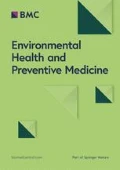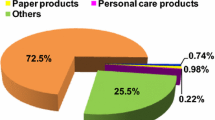Abstract
Objectives
Concerns over dietary exposure to bisphenol A (BPA), an endocrine disruptor, have been raised because BPA is contained in resins and plastics commonly used for the preservation of food and beverages. The purpose of the present study was to assess daily intake levels of BPA in a group of male subjects by measuring total urinary BPA (free BPA plus BPA released by treatment with β-glucuronidase), as well as determining intra-individual variation in BPA excretion.
Methods
Twenty-four-hour urine was collected from 5 subjects for 5 consecutive days for the evaluation of between-day variation in urinary BPA excretion and from 36 male subjects for the estimation of the level of daily BPA intake. BPA in the urine samples was measured by GC/MS/MS following enzymatic hydrolysis of BPA glucuronate, solid phase extraction, and derivatization.
Results
A large between-day variation was found over 5 days for the daily excretion of urinary BPA in the 5 subjects. The daily excretion of urinary BPA was distributed log-normally in the 36 male subjects, with the median value being 1.2 μg/day (range: <0.21–14 μg/day), which was far below the Tolerable Daily Intake (0.01 mg/kg bw) recommended by a scientific committee in the European Commission in 2002. However, the maximum estimated intake per body weight (0.2 μg/kg/day) was only one order of magnitude lower than the reported lowest level for reproductive/behavioral effects in pregnant mice (2 μg/kg/day).
Conclusions
Measuring urinary BPA in urine is a suitable approach for estimating short-term BPA intake levels in individuals and/or estimating the average exposure level of populations. Urine analyses will be increasingly important in the human health risk assessment of BPA.
Similar content being viewed by others
References
Dodds EC and Lawson W. Molecular structure in relation to oestrogenic activity. Compounds without a phenanthrene nucleus. Proc. Royal Soc. 1938; 125: 222–232.
Krishnan AV, Stathis P, Permuth SF, Tokes L, Feldman D. Bisphenol-A: an estrogenic substances is released from polycarbonate flasks during autoclaving. Endocrinology 1993; 132: 2279–2286.
Scientific Committee on Food, Opinion of the scientific committee on food on bisphenol A. SCF/CS/PM/3936 Final 3 May 2002, European Commission.
Nagel SC, vom Saal FS, Thayer CA, Dhar MG, Boechler M., Welshons WV. Relative binding affinity-serum modified access (RBA-SMA) assay predicts the relative in vivo bioactivity of the xenoestrogens bisphenol a and octylphenol. Environ. Health Perspect. 1997; 105: 70–76.
vom Saal FS, Cooke PS, Buchanan DL, Palanza P, Thayer KA, Nagel SC, Parmigiani S, Welshons WV. A physiologically based approach to the study of bisphenol A and other estrogenic chemicals on the size of reproductive organs, daily sperm production, and behavior. Toxicol. Ind. Health 1998; 14: 239–260.
Howdeshell KL, Hotchkiss AK, Thayer KA, Vandenbergh JG, vom Saal FS. Exposure to bisphenol A advances puberty. Nature 1999; 401: 763–764.
Welshons WV, Nagel SC, Thayer KA, Judy BM, vom Saal FS. Low-dose bioactivity of xenoestrogens in animals: fetal exposure to low doses of methoxychlor and other xenoestrogens increases adult prostate size in mice. Toxicol. Ind. Health 1999; 15: 12–25.
Palanza P, Howdeshell KL, Parmigiani S, vom Saal FS. Exposure to a low dose of bisphenol A during fetal life or in adulthood alters maternal behavior in mice. Environ. Health Perspect. 2002; 110 Suppl 3: 415–422.
Kawai K, Nozaki T, Nishikata H, Aou S, Takii M, Kubo C. Aggressive behavior and serum testosterone concentration during the maturation process of male mice: the effects of fetal exposure to bisphenol A. Environ. Health Perspect. 2003; 111: 175–178.
Sakaue M, Ohsako S, Ishimura R, Kurosawa S, Kurohmaru M, Hayashi Y, Aoki Y, Yonemoto J, Tohyama C. Bisphenol-A affects spermatogenesis in the mature rat even at a low dose. J. Occupational Health 2001; 43: 185–190.
Kawamura Y, Sano H, Yamada T. Migration of bisphenol A from can coatings to drinks. Syokueiki. 1999; 40: 158–165.
Ozaki A, Yamaguchi Y, Fujita T, Xenoestrogens and its relatives in paper products used in contact with food. The 4th annual meeting of the Japan society of endocrine disrupters research. Program and Abstracts. 2002: 126.
Kurebayashi H, Harada R, Stewart RK, Numata H, Ohno Y. Disposition of a low dose of bisphenol A in male and female cynomolgus monkeys. Toxicol. Sci. 2002; 68: 32–42.
Völkel W, Colnot T, Csanady GA, Filser JG, Dekant W. Metabolism and kinetics of bisphenol A in humans at low doses following oral administration. Chem. Res. Toxicol. 2002; 15: 1281–1287.
Brock JW, Yoshimura Y, Barr JR, Maggio VL, Graiser SR, Nakazawa H, Needham LL. Measurement of bisphenol A levels in human urine. J. Expo. Anal. Environ. Epidemiol. 2001; 11: 323–328.
Imai H, Morita M. Determination of bisphenol A-β-glucuronide in human urine. Environ. Sci. 2002; 9: 120.
Hanaoka T, Kawamura N, Hara K, Tsugane S. Urinary bisphenol A and plasma hormone concentrations in male workers exposed to bisphenol A diglycidyl ether and mixed organic solvents. Occup. Environ. Med. 2002; 59: 625–628.
Ouchi K, Watanabe S. Measurement of bisphenol A in human urine using liquid chromatography with multi-channel coulometric electrochemical detection. J. Chromatogr. B Analyt. Technol. Biomed. Life Sci. 2002; 780: 365–370.
Matsumoto A, Kunugita N, Kitagawa K, Isse T, Oyama T, Foureman GL, Morita M, Kawamoto T. Bisphenol A levels in human urine. Environ. Health Perspect. 2003; 111: 101–104.
Yang M, Kim SY, Lee SM, Chang SS, Kawamoto T, Jang JY. Ahn YO. Biological monitoring of bisphenol A in a Korean population. Arch. Environ. Contam. Toxicol. 2003; 44: 546–551.
Report of Special Research from the National Institute for Environmental Studies, Japan SR-46-2002. 2002; 3–6 (in Japanese)
Tsukioka T, Terasawa J, Hatakeyama Y, Sato S, Nakazawa H, Makino T. Estimation of quantity of BPA intake by urine sample. The 12th Symposium on Environmental Chemistry, Programs and Abstracts 2003; 444–445 (in Japanese).
Imanaka M. Survey of food contamination and dietary intake of phenols. Report of health science research grants from ministry of health, welfare and labor of Japan (Research on environmental health), 2001 (in Japanese).
Tsukioka T. personal communication, 2003.
Ashby J, Tinwell H, Haseman J. Lack of effects for low dose levels of bisphenol A and diethylstilbestrol on the prostate gland of CF1 mice exposed in utero. Regul. Toxicol. Pharmacol. 1999; 30: 156–166.
Cagen SZ, Waechter JM Jr, Dimond SS, Breslin WJ, Butala JH, Jekat FW, Joiner RL, Shiotsuka RN, Veenstra GE, Harris LR. Normal reproductive organ development in CF-1 mice following prenatal exposure to bisphenol A. Toxicol. Sci. 1999; 50: 36–44.
Cagen SZ, Waechter JM Jr, Dimond SS, Breslin WJ, Butala JH, Jekat FW, Joiner RL., Shiotsuka RN, Veenstra GE, Harris LR. Normal reproductive organ development in Wistar rats exposed to bisphenol A in the drinking water. Regul. Toxicol. Pharmacol. 1999; 30: 130–139.
Author information
Authors and Affiliations
Corresponding author
Rights and permissions
About this article
Cite this article
Arakawa, C., Fujimaki, K., Yoshinaga, J. et al. Daily urinary excretion of bisphenol A. Environ Health Prev Med 9, 22–26 (2004). https://doi.org/10.1265/ehpm.9.22
Received:
Accepted:
Issue Date:
DOI: https://doi.org/10.1265/ehpm.9.22




